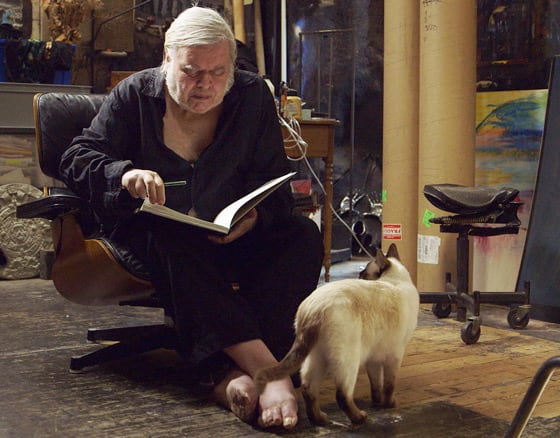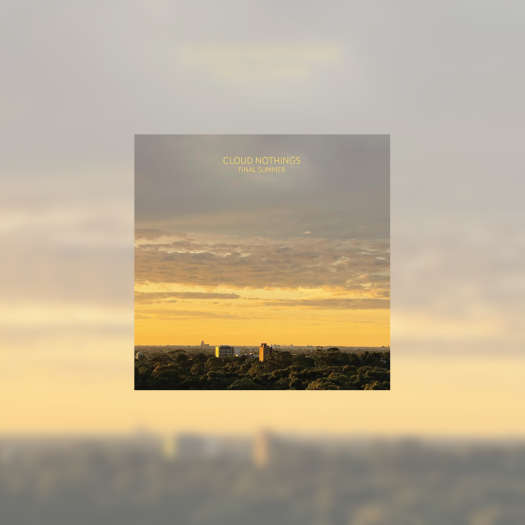There's a part early on in Dark Star: H. R. Giger's World, director Belinda Sallin's documentary about the surrealist Swiss artist and winner of an Academy Award for his design work on Alien, in which psychologist and friend Stanislav Grof discusses the main motifs found in Giger's work: dark, twisting passages; the feminine figure; birth, life and death. According to Grof, all this imagery stems from a "perinatal experience… the trauma of birth, which we have never consciously processed."
That sentiment rings throughout Dark Star, a documentary that is as much about the inner workings of the acclaimed artist as it is the bizarre home he created for himself, and how that house acts as a strange microcosm and outward representation of the artist's mind, life and work.
Nestled next to a train line in Zurich, Switzerland, Giger's home is an archive of his work and the works that inspired him over the years. Books fill the bathtub, nooks and crannies abound, and throughout the film it appears as if it's hard for Sallin's cameras to crane themselves far enough around corners to capture the pint-sized artist in his prime.
But that seems to be the point: Dark Star is more of a glimpse into the artist's mind rather than a full-fledged critical or biographical examination of his work. Archival footage and talking heads, including his former lovers, assistants (including Triptykon's Thomas Gabriel Fischer, who first began being mentored by the artist during his Celtic Frost days) and friends paint a somewhat clear picture of the artist, but it's the more unhinged moments at home — Giger riding a miniature train through his gothic garden, desperately trying to shoo his cat Muggi away before it runs over its tail; watching a classic horror movie over drinks with his romantic partner — that allow us to feel less like visitors and more like actual inhabitants of his world.
At times, it can be unsettling; the darkness found throughout his home is overwhelming, and the knowledge that everything was filmed shortly before his passing on May 12, 2014 gives the whole thing a slightly macabre feel. But this was a man who (as he tells it in the film's opening scene), as a five-year-old boy, once tied a string to a human skull and dragged it around his neighbourhood to prove to himself that he wasn't afraid of death (even though he admits to the camera that he actually was).
The idea of conquering fear is at the centre of all his artwork, and to see Giger still creating, with death his door, still fearless in the face of old age, is both cathartic and inspiring. We may not stay long, but traveling into Giger's universe for just a short time is a worthwhile adventure nonetheless.
(Icarus Films)That sentiment rings throughout Dark Star, a documentary that is as much about the inner workings of the acclaimed artist as it is the bizarre home he created for himself, and how that house acts as a strange microcosm and outward representation of the artist's mind, life and work.
Nestled next to a train line in Zurich, Switzerland, Giger's home is an archive of his work and the works that inspired him over the years. Books fill the bathtub, nooks and crannies abound, and throughout the film it appears as if it's hard for Sallin's cameras to crane themselves far enough around corners to capture the pint-sized artist in his prime.
But that seems to be the point: Dark Star is more of a glimpse into the artist's mind rather than a full-fledged critical or biographical examination of his work. Archival footage and talking heads, including his former lovers, assistants (including Triptykon's Thomas Gabriel Fischer, who first began being mentored by the artist during his Celtic Frost days) and friends paint a somewhat clear picture of the artist, but it's the more unhinged moments at home — Giger riding a miniature train through his gothic garden, desperately trying to shoo his cat Muggi away before it runs over its tail; watching a classic horror movie over drinks with his romantic partner — that allow us to feel less like visitors and more like actual inhabitants of his world.
At times, it can be unsettling; the darkness found throughout his home is overwhelming, and the knowledge that everything was filmed shortly before his passing on May 12, 2014 gives the whole thing a slightly macabre feel. But this was a man who (as he tells it in the film's opening scene), as a five-year-old boy, once tied a string to a human skull and dragged it around his neighbourhood to prove to himself that he wasn't afraid of death (even though he admits to the camera that he actually was).
The idea of conquering fear is at the centre of all his artwork, and to see Giger still creating, with death his door, still fearless in the face of old age, is both cathartic and inspiring. We may not stay long, but traveling into Giger's universe for just a short time is a worthwhile adventure nonetheless.




